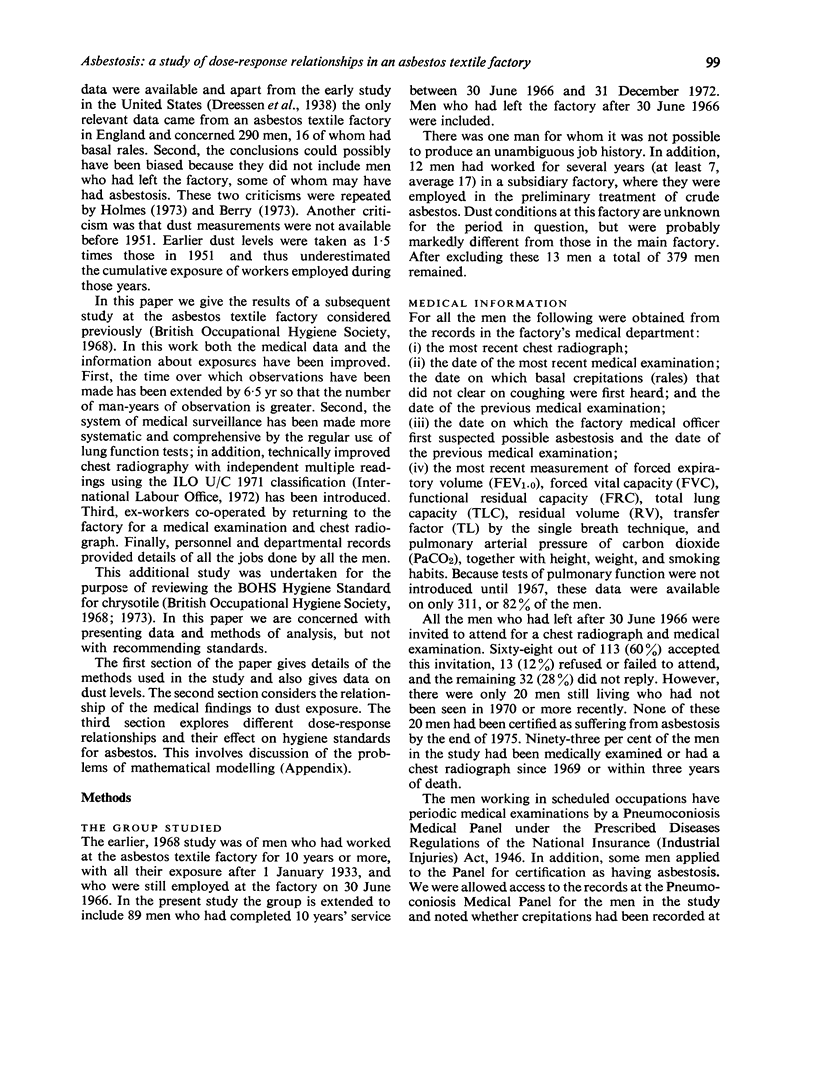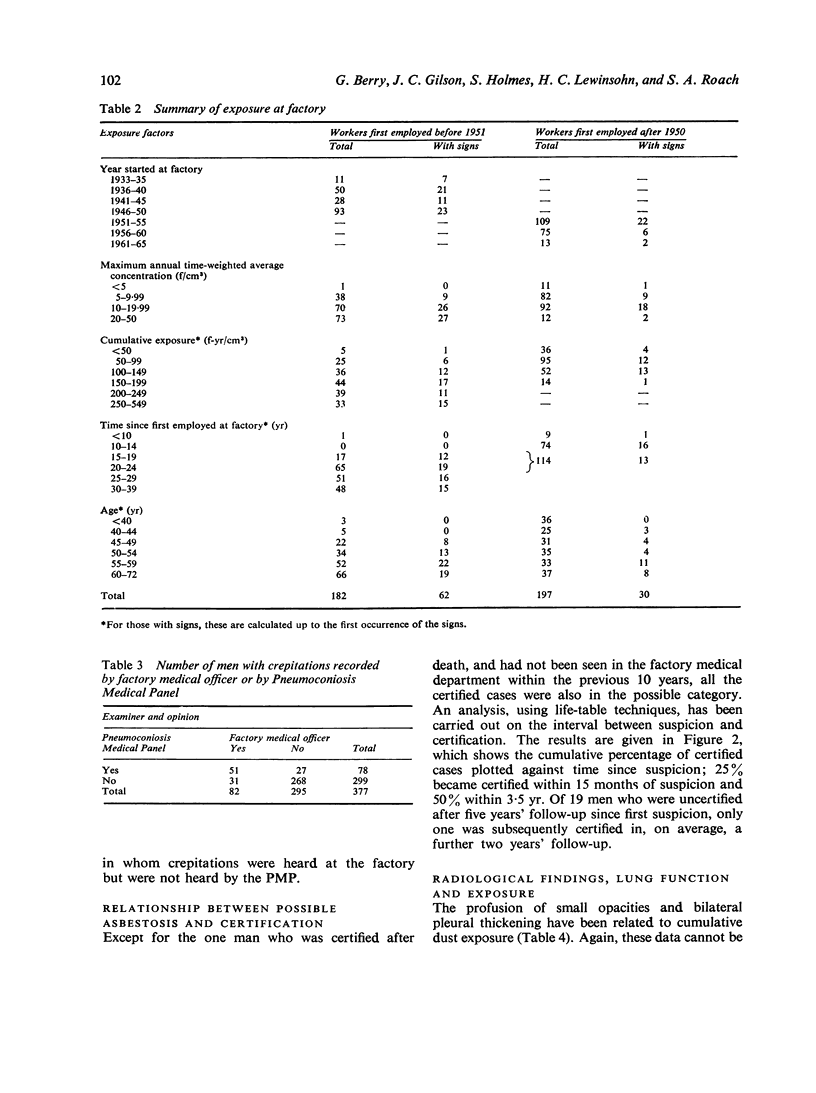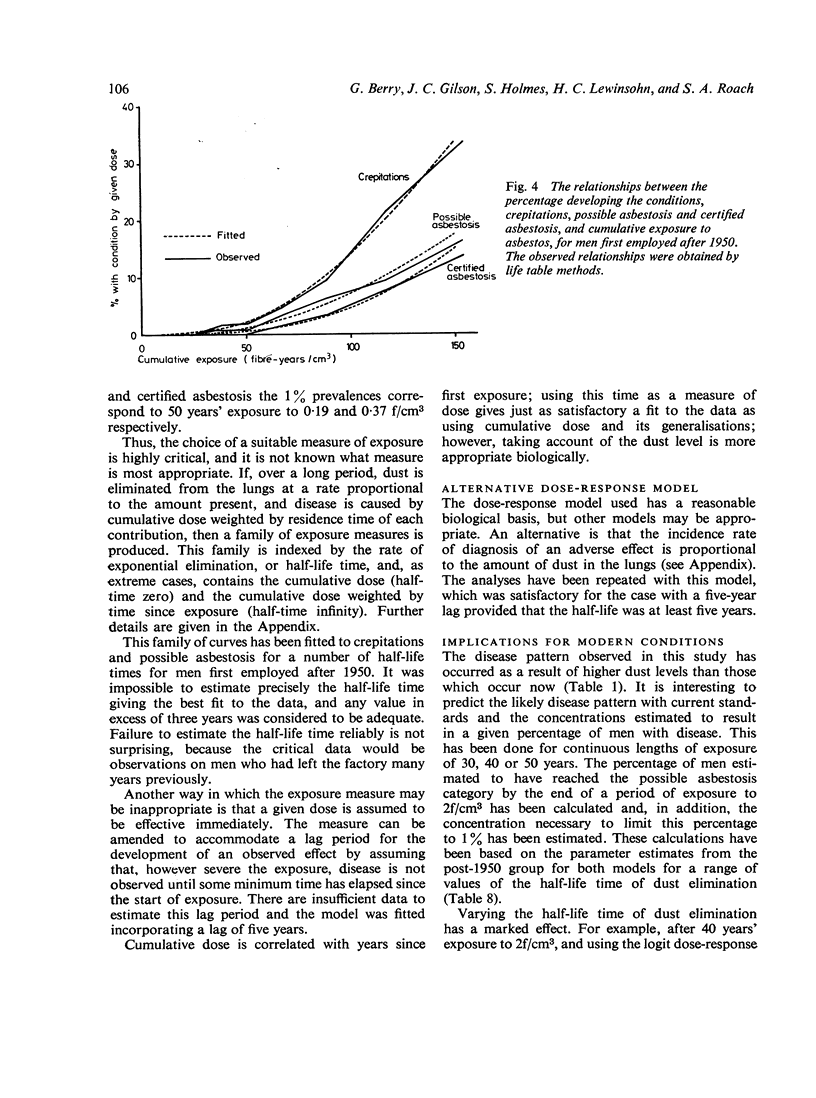Abstract
ABSTRACT A group of 379 men who had worked at an asbestos textile factory for at least 10 years has been followed up. The prevalence of crepitations, 'possible asbestosis', certified asbestosis, small opacities in the chest radiograph and values of lung function have been related to dust levels. The type of asbestos processed was predominantly chrysotile although a substantial amount of crocidolite had also been used in the past. There was a higher prevalence of crepitations than had been observed previously at the same factory. The presence of crepitations is not a specific effect of asbestos exposure and 'possible asbestosis', a combined judgement of two physicians on whether a man had developed signs which might be attributable to early asbestosis, was preferred. Fifty per cent of men with a diagnosis of possible asbestosis were certified as suffering from asbestosis by the pneumoconiosis Medical Panel within 3-5 yr. The most reliable data relate to men first employed after 1950; 6·6% of men in this group had possible asbestosis after an average length of follow-up of 16 yr and an average exposure to 5 fibre/cm3 where the dust levels were determined by static area samplers. The forced expiratory volume and forced vital capacity declined significantly with exposure, after allowing for age and height, but there was no decline in the total lung capacity. The transfer factor also declined with exposure, but not to a statistically significant extent. The non-smokers and light smokers as a group had less crepitations, asbestosis and small opacities on the chest radiograph than heavier smokers with similar exposure. Combining dust concentrations to form the cumulative dose may not be completely satisfactory, and a family of measures was investigated which allows for elimination of dust from the lungs and includes the cumulative dose as a special case. Because the rate of elimination of dust from the lungs is unknown and cannot be estimated from the data, this approach leads to a wide range of possible interpretations of the data; for example the concentration such that possible asbestosis occurs in no more than 1% of men after 40 years' exposure could be as high as 1·1 fibres/cm3 or may have to be as low as 0·3 fibres/cm3. This range is wide because the data relate to higher dust levels, and a shorter period of follow-up. Until data are available on groups exposed to lower levels it will not be possible to assess the effects of the current standard with any certainty. However, the results of this study show that it is important to continue to reduce dust levels to values as low as possible.
Full text
PDF














Selected References
These references are in PubMed. This may not be the complete list of references from this article.
- Jahr J. Dose-response basis for settling a quartz threshold limit value: a new, simple formula for calculating the "lifetime dose" of quartz. Arch Environ Health. 1974 Dec;29(6):338–340. doi: 10.1080/00039896.1974.10666611. [DOI] [PubMed] [Google Scholar]
- McDonald J. C., Becklake M. R., Gibbs G. W., McDonald A. D., Rossiter C. E. The health of chrysotile asbestos mine and mill workers of Quebec. Arch Environ Health. 1974 Feb;28(2):61–68. doi: 10.1080/00039896.1974.10666438. [DOI] [PubMed] [Google Scholar]
- McVittie J. C. Asbestosis in Great Britain. Ann N Y Acad Sci. 1965 Dec 31;132(1):128–138. doi: 10.1111/j.1749-6632.1965.tb41096.x. [DOI] [PubMed] [Google Scholar]
- Morgan A., Lally A. E., Holmes A. Some observations on the distribution of trace metals in chrysotile asbestos. Ann Occup Hyg. 1973 Nov;16(3):231–240. doi: 10.1093/annhyg/16.3.231. [DOI] [PubMed] [Google Scholar]
- Newhouse M. L. Asbestos in the work place and the community. Ann Occup Hyg. 1973 Aug;16(2):97–107. doi: 10.1093/annhyg/16.2.97. [DOI] [PubMed] [Google Scholar]
- Weill H., Ziskind M. M., Waggenspack C., Rossiter C. E. Lung function consequences of dust exposure in asbestos cement manufacturing plants. Arch Environ Health. 1975 Feb;30(2):88–97. doi: 10.1080/00039896.1975.10666650. [DOI] [PubMed] [Google Scholar]
- Weiss W. Cigarette smoking and diffuse pulmonary fibrosis. Am Rev Respir Dis. 1969 Jan;99(1):67–72. doi: 10.1164/arrd.1969.99.1.67. [DOI] [PubMed] [Google Scholar]
- Weiss W. Cigarette smoking, asbestos, and pulmonary fibrosis. Am Rev Respir Dis. 1971 Aug;104(2):223–227. doi: 10.1164/arrd.1971.104.2.223. [DOI] [PubMed] [Google Scholar]


